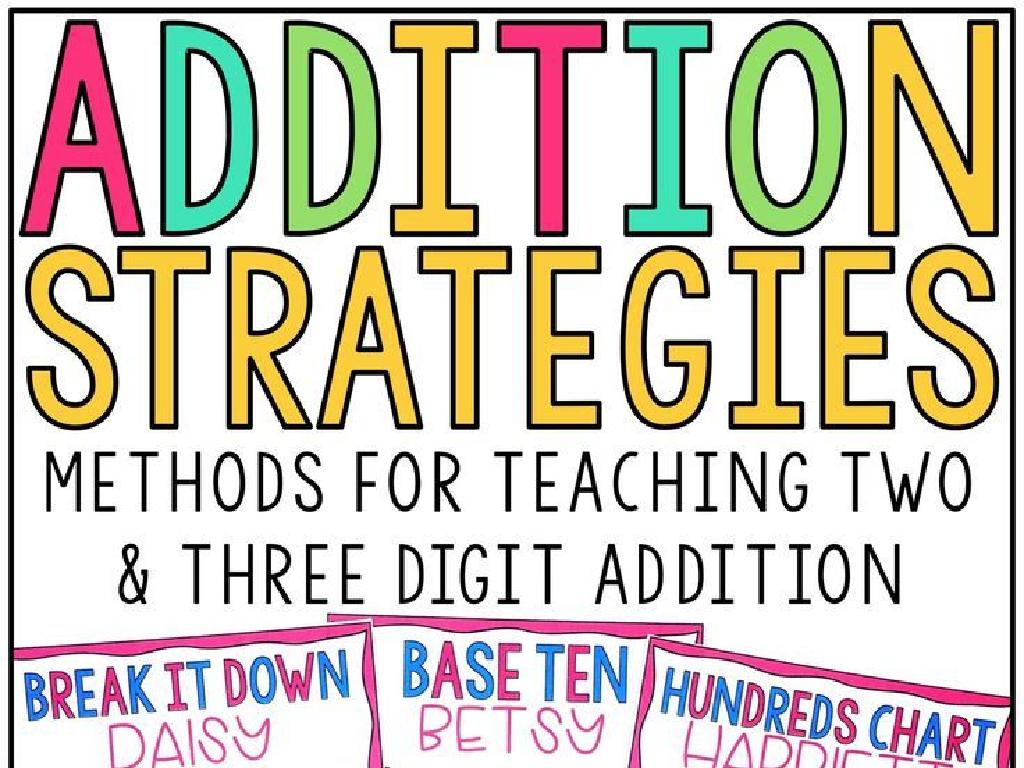Subject-Verb Agreement
Subject: Language arts
Grade: Seventh grade
Topic: Verb Types
Please LOG IN to download the presentation. Access is available to registered users only.
View More Content
Mastering Subject-Verb Agreement
– Understanding verb types
– Verbs can be action, linking, or helping.
– Defining subject-verb agreement
– It’s when the subject and verb match in number.
– The significance of correct agreement
– Ensures clarity and correctness in writing.
– Examples in sentences
– ‘He runs’ vs. ‘They run’ shows agreement.
|
This slide introduces the concept of subject-verb agreement, which is a cornerstone of proper grammar in English. Start by discussing the different types of verbs (action, linking, and helping) to lay the groundwork. Then, explain that subject-verb agreement means the subject and verb must both be singular or both be plural. Emphasize the importance of this agreement in making sentences clear and grammatically correct. Use simple examples to illustrate how the verb changes depending on whether the subject is singular or plural. Encourage students to think of their own examples and to be mindful of subject-verb agreement in their writing.
Mastering Subject-Verb Agreement
– Define a sentence subject
The subject is who or what the sentence is about.
– Define a sentence verb
A verb expresses action or being.
– Subject and verb examples
In ‘The cat sleeps,’ ‘cat’ is the subject, and ‘sleeps’ is the verb.
– Practice identifying subjects and verbs
|
This slide introduces the foundational elements of subject-verb agreement, starting with the definitions of subjects and verbs. A subject is the main noun or pronoun that the sentence is about, while a verb is the action or state of being that the subject is doing. Provide clear examples to illustrate the concept, such as ‘The dog barks,’ where ‘dog’ is the subject and ‘barks’ is the verb. Emphasize the importance of matching the subject with the correct verb form to maintain agreement. After explaining, engage students with practice sentences where they identify the subjects and verbs, reinforcing their understanding of how a sentence is structured.
Singular vs. Plural Subjects
– Defining singular & plural subjects
– Singular subjects are one, plural are more than one.
– Verbs adjust to subject number
– Singular verbs often end in ‘s’, while plural verbs do not.
– Examples: Singular & plural pairings
– ‘He runs’ is singular, ‘They run’ is plural.
– Practice with subject-verb agreement
|
This slide introduces the concept of subject-verb agreement, focusing on the difference between singular and plural subjects. Begin by defining what makes a subject singular (one entity) or plural (more than one entity). Explain how verbs change form depending on whether the subject is singular or plural, typically with the addition of an ‘s’ for singular third-person subjects. Provide clear examples of subject-verb pairings to illustrate the concept. Conclude with an interactive practice activity where students identify and correct sentences with subject-verb agreement errors. This will help reinforce the rules and ensure students can apply them in their writing.
Mastering Subject-Verb Agreement
– Understand basic agreement rules
– Subjects and verbs must match in number
– Learn special case scenarios
– Words between subject and verb can confuse
– Identify common agreement errors
– ‘He runs’ is correct, but ‘He run’ is not
– Practice with class activities
|
This slide is aimed at helping students grasp the fundamental rules of subject-verb agreement, which is crucial for constructing grammatically correct sentences. Start by explaining that the subject and verb in a sentence must agree in number, meaning both must be singular or both must be plural. Highlight special cases, such as when intervening phrases or clauses can lead to errors in agreement. Provide examples of common mistakes to illustrate these points. Engage the class with activities where they correct sentences or create their own, ensuring they apply the rules they’ve learned. This interactive approach will reinforce the concepts and help students avoid typical errors.
Mastering Subject-Verb Agreement
– Practice correct verb forms
– Match singular/plural subjects with verbs
– Class participation examples
– Students suggest verbs for sentences
– Understand why forms are correct
– Explanation ties to number agreement rules
– Interactive verb agreement exercises
|
This slide is aimed at reinforcing the concept of subject-verb agreement through practice and participation. Begin by reviewing the rules for matching singular and plural subjects with their corresponding verb forms. Engage the class with interactive examples where students suggest the correct verb form for given sentences. After each response, explain why the chosen verb form is correct, linking back to the rules of subject-verb agreement. Emphasize the importance of number agreement and consistency in writing. Plan for an activity where students work in pairs or small groups to create their own sentences, ensuring proper subject-verb agreement, and then share with the class for a group discussion.
Complex Subject-Verb Agreement
– Compound subjects agreement
– When subjects are joined by ‘and’, the verb is plural.
– Interrupting phrases in sentences
– Phrases that don’t affect the verb’s number. E.g., ‘The cat, along with the dogs, runs.’
– Agreement with indefinite pronouns
– Words like ‘everyone’ and ‘nobody’ take singular verbs.
– Practice examples
|
This slide delves into more complex aspects of subject-verb agreement, crucial for constructing grammatically correct sentences. Start by explaining how compound subjects typically take a plural verb, except when the compound subject is considered a single entity or when it’s connected by ‘or’ or ‘nor’. Highlight how interrupting phrases do not change the number of the subject. Then, discuss indefinite pronouns and their tricky nature, as some are always singular, some always plural, and some depend on the context. Provide practice examples for each case to solidify understanding. Encourage students to identify the subject and verb in sentences and to determine their agreement, especially in sentences that include these complexities.
Class Activity: Subject-Verb Agreement Challenge
– Form teams for a grammar game
– Identify correct verb forms in sentences
– Each team finds verbs that match the subject in number and tense
– Discuss team answers collectively
– Share answers and learn from each team’s findings
– Clarify rules and confusions
– Address any misunderstandings about subject-verb agreement
|
This interactive class activity is designed to reinforce the concept of subject-verb agreement through a collaborative and competitive game. Divide the class into small teams and provide each with a set of sentences. Their task is to identify and correct any subject-verb agreement errors. Afterward, bring the class together to discuss the answers, allowing teams to explain their reasoning. This is a great opportunity to clarify common misconceptions and solidify understanding of how subjects and verbs must agree in number and tense. Possible variations of the activity could include timed challenges, sentence creation, or error correction races to add excitement to the learning process.
Wrapping Up: Subject-Verb Agreement
– Recap of subject-verb agreement
– Homework: 10 sentences practice
– Create sentences where the subject and verb agree in number
– Emphasize the value of practice
– Consistent practice is key to mastering language skills
– Reminder for next class preparation
|
As we conclude today’s lesson, remind students of the key points about subject-verb agreement. For homework, they are to write 10 original sentences that demonstrate correct subject-verb agreement, reinforcing what they’ve learned. Emphasize the importance of practice in mastering language arts skills. Encourage students to review their notes and come prepared for the next class, where they will continue to build upon these foundational grammar skills.





